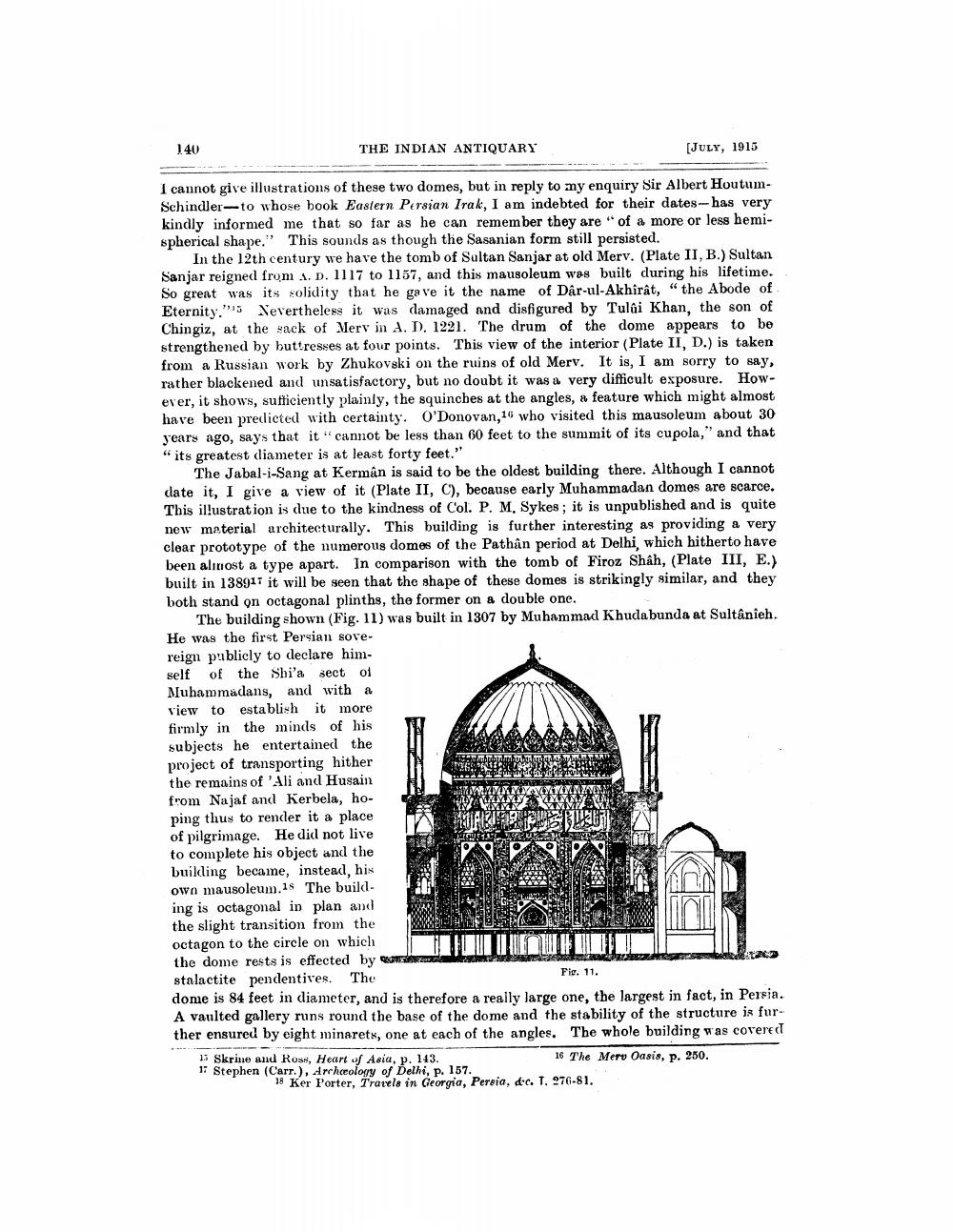________________
140
THE INDIAN ANTIQUARY
(JULY, 1915
I cannot give illustrations of these two domes, but in reply to my enquiry Sir Albert HoutumSchindler--to whose book Eastern Persian Irak, I am indebted for their dates--has very kindly informed me that so far as he can remember they are of a more or less hemispherical shape." This sounds as though the Sasanian form still persisted.
In the 12th century we have the tomb of Sultan Sanjar at old Merv. (Plate II, B.) Sultan Sanjar reigned from D. 1117 to 1157, and this mausoleum was built during his lifetime. So great was its solidity that he gave it the name of Dar-ul-Akhirât, “the Abode of Eternity." Nevertheless it was damaged and disfigured by Tulai Khan, the son of Chingiz, at the wack of Merv in d. D. 1221. The drum of the dome appears to be strengthened by buttresses at four points. This view of the interior (Plate II, D.) is taken from a Russian work by Zhukovski on the ruins of old Merv. It is, I am sorry to say, rather blackened and unsatisfactory, but no doubt it was a very difficult exposure. However, it shows, sufficiently plainly, the squinches at the angles, a feature which might almost have been predicted with certainty. O'Donovan, 16 who visited this mausoleum about 30 years ago, says that it cannot be less than 60 feet to the summit of its cupola," and that "its greatest diameter is at least forty feet."
The Jabal-i-Sang at Kerman is said to be the oldest building there. Although I cannot date it, I give a view of it (Plate II, C), because early Muhammadan domes are scarce. This illustration is due to the kindness of Col. P. M. Sykes; it is unpublished and is quite new material architecturally. This building is further interesting as providing a very clear prototype of the numerous domes of the Pathîn period at Delhi, which hitherto have been alınost a type apart. In comparison with the tomb of Firoz Shah, (Plate III, E.) built in 138917 it will be seen that the shape of these domes is strikingly similar, and they both stand on octagonal plinths, the former on a double one.
The building shown (Fig. 11) was built in 1307 by Muhammad Khudabunda at Sultânieh. He was the first Persian sovereign publicly to declare himself of the Shi'a sect of Muhammadans, and with a view to establish it more firmly in the minds of his subjects he entertained the project of transporting hither the remains of 'Ali and Husain from Najaf and Kerbela, hoping thus to render it a place of pilgrimage. He did not live to complete his object and the building became, instead, his own mausoleum.is The building is octagonal in plan and the slight transition from the octagon to the circle on which the dome rests is effected by m stalactite pendentives. The
Fig. 11. dome is 84 feet in diameter, and is therefore a really large one, the largest in fact, in Persia. A vaulted gallery runs round the base of the dome and the stability of the structure is further ensured by eight minarets, one at each of the angles. The whole building was corered 15 Skrine and Rost, Heart of Asia, p. 143.
16 The Merv Oasis, p. 250. 1: Stephen (Carr.), archeology of Delhi, p. 157.
18 Ker Porter, Travels in Georgia, Persia, &c. T. 976-81.
SUCHE




